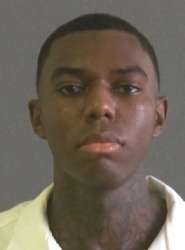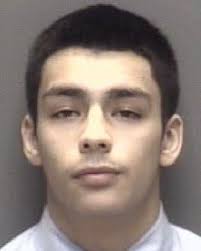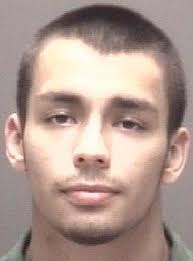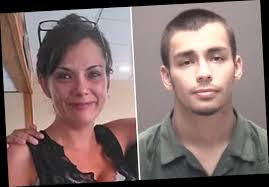
Christine Paolilla was seventeen when she murdered four of her friends. According to court documents Christine Paolilla and Christopher Snider would enter a home and shoot and kill four young people in 2003. This teen killer would not be arrested until 2006 when an anonymous tip would lead to her arrest. Christopher Snider would commit suicide before he could be arrested.
Christine Paolilla 2023 Information
SID Number: 07188577
TDCJ Number: 01529580
Name: PAOLILLA,CHRISTINE MARIE
Race: W
Gender: F
DOB: 1986-03-31
Maximum Sentence Date: LIFE SENTENCE
Current Facility: MOUNTAIN VIEW
Projected Release Date: LIFE SENTENCE
Parole Eligibility Date: 2046-07-22
Offender Visitation Eligible: YES
Christine Paolilla Other News
In the spring of 2003, things were looking up for 17-year-old Christine Paolilla, a shy teenager who had always struggled to fit in. She was friends with two popular girls at school — Rachael Koloroutis and Tiffany Rowell — and she had been voted “Miss Irresistible” by the student body at Clear Lake High School in suburban Houston.
But on the afternoon of July 18, 2003, Christine’s life changed forever. Four youths were found shot multiple times at point blank range in a home in the placid Clear Lake neighborhood. Two of the victims were her friends, Koloroutis and Rowell, who had recently graduated. Koloroutis was planning to attend college in the fall.
The police were stunned, and stumped as to who would want the youths dead.
“There was a lot of rage and anger behind these killings and so, therefore, we thought … perhaps there was a personal relationship between the victims in the home and the killer,” Houston Police Sgt. Brian Harris told ABC News.
It would take three years to unravel the mystery. After numerous dead ends, police caught a big break in July 2006, when an anonymous tipster called. The tipster described facts only the killers could have known and gave them two names — a boy, Chris, and a girl: Christine Paolilla.
Christine Paolilla was arrested, tried and convicted of the crime. She is now appealing the conviction. “Chris” was Chris Snider, Christine’s boyfriend in high school, who committed suicide after he learned police were on his trail.
The question that haunted everyone, including the police, was, “Why?” The details didn’t seem to add up. Rachael and Tiffany had befriended Christine Paolilla and offered her advice, including beauty tips. The friends even carried pictures of each other in their wallets.
Why would Christine Paolilla want to kill her friends?
Christine’s parents, Lori Paolilla and stepfather Tom Dick, spoke to “20/20” exclusively about their daughter’s life before July 18, 2003.
Christine Paolilla spent her childhood in suburban Long Island, N.Y. Her mother, Lori Paolilla, told ABC News that the girl was “very outgoing, outspoken, though shy at times… she was the apple of Daddy’s eye.” Christine’s father, Charles Paolilla, was a construction worker and her mother stayed home to raise Christine and her older brother, John.
Christine Paolilla was just 2 years old when tragedy hit. Lori Paolilla described the painful day.
“Her father got up and went to work and never came home,” she said.
Charles Paolilla was killed by falling bricks during construction on a high-rise in New York City.
“I had to go home,” Lori Paolilla told ABC News, “and tell my children that Daddy won’t be coming home anymore.”
A few months later, Christine’s grandfather and great-grandmother also passed away. According to her mother, Christine Paolilla started asking questions: “‘Mommy, I don’t understand … why is it that people I love go away?’”
Her mother says she tried to raise the children on her own, but the pain of losing her husband led her to drug addiction. She eventually lost control of her world and, temporarily, custody of her children. At age 7, Christine Paolilla went to live with her grandparents.
“She didn’t really understand,” Paolilla said. “She would call me on the phone and cry, ‘Mommy, can’t I come home?’”
Psychiatrist Gail Saltz, author of “Anatomy of a Secret Life: The Psychology of Living a Lie,” described the impact such a loss could have on a young girl.
“Losing her father at an early age puts someone a risk,” Saltz told ABC News. “It’s abandonment, a very frightening one … and then, of course, be[ing] essentially abandoned by your mother in the setting of her using drugs, that’s sort of a double whammy because that is losing the most important person in your life. … Hard to not internalize that as a tremendous rejection, … [a] blow to self-esteem and questions of how loveable am I if my mother … is no longer taking care of me.”
Christine Paolilla’s suffering didn’t end there. By the time she was in kindergarten, she was diagnosed with an irreversible hair-loss condition called alopecia.
“She would wake up in the morning and there would be clumps of hair all over her pillow, patches here, patches there,” Paolilla said. “And eventually led to where it affected her eyes so she lost her eyebrows, she lost her eyelashes.”
As a young child, Christine Paolilla wore wigs to hide her affliction from the world.
“That was devastating,” said Paolilla. “She had poor vision so she had what I guess most folks would know as Coke-bottle glasses, and [she] started being ridiculed by young children. … Classmates would come up behind her, pull her wig off her head.
“It was so painful to watch. I can’t even imagine really, truly how she was feeling. As a parent, as a mother the pain of a child, waking up in the morning thinking, ‘What am I going to have to go through today? Who is going to hurt me today?’ It was very difficult for her.”
Saltz said the hair loss would have been a major psychological obstacle.
“Psychologically, to a young person, this is going to take a huge toll,” Saltz said. “Hair is hugely important to girls, to women, it’s a symbol of femininity, it’s a symbol of feminine power … alopecia is a pretty devastating condition.”
Christine’s early teen years were a struggle. But eventually she was able to forge new friendships that helped her feel like she belonged.
Lori Paolilla recalled her daughter’s joy at having made new high school friends.
“‘Mom,’ she said, ‘I made two new friends who are the sweetest girls I ever met,’” Paolilla said. “I said ‘who are they?’ She said, ‘Rachael and Tiffany.’ … She couldn’t speak highly enough about them. How much fun they were. How loving they were, how they had so much fun … Every minute they spent together was lively and fun, and they laughed all the time and I saw such a change in her personality.”
Tiffany and Rachael were a year ahead of Christine Paolilla in school. “She genuinely seemed very happy when she started to hang around with those girls,” said Paolilla.
Rachael was beautiful and popular and may have helped Christine feel like a normal teenager. The intensity of the relationship was understandable, said Saltz. “That relationship would be extra important, full of longings,” she said.
Rachael’s father wasn’t surprised she took Christine Paolilla under her wing.
“Rachael was the kind of person that always looked out for the underdog, always tried to help others,” George Koloroutis told ABC News. “And because of this affliction that Paolilla had … Rachael really felt sorry for her.”
Paolilla said one sign that Christine Paolilla trusted her new friends was that she “felt OK without the wig on with them, which is not something that she did with many of her friends.”
Christine also had a friend her parents did not approve of: Chris Snider. Christine briefly met Snider in school, when she was in the eighth grade. He was about two years older and didn’t look like her other friends.
He had “body piercings, spiked hair, chains hanging from his jeans … there was something in his eyes and every time I saw him it made me very uncomfortable,” said Lori Paolilla, adding said Snider did jail time for armed robbery, and when he got out he went straight to Christine Paolilla, now 16. Christine felt bad for him because nobody wanted to be his friend and she thought she could help him, said Paolilla.
Christine and Chris began dating. According to Christine’s mother and stepfather, Snider started isolating Christine from her family and friends. Paolilla said Snider emotionally abused Christine Paolilla, even showing up at school one day and pulling her wig off to embarrass her in front of her classmates. Despite it all, Christine appeared to cling to the relationship.
“Typically in an abusive relationship,” said Saltz, “the abuser wants to isolate, dominate. … And he would be jealous of, and potentially want to get rid of anybody else in her life.” It is not uncommon, according to the psychiatrist, for a woman who has been bullied to fall in love with her abuser.
Dick said Snider had some sort of hold on Christine Paolilla. “We did everything in our power to get him away from her, but you know she’s 16, 17 years old. There’s only so much you can do.” He said they tried grounding Christine and taking away car privileges, but “[Snider] had some sort of mental control over her that we couldn’t break.”
Christine’s parents were additionally concerned about Snider’s drug use. The parents consulted with attorneys and police officers, they said, and even tried to get a restraining order and have Snider arrested, to no avail. “We talked to her about it until we were blue in the face,” said Dick. “She just felt she was going be able to fix him, no matter what he did.”
Saltz tied the relationship to Christine’s early loss of her father. “[I]f you lost a father very early in life, you may be susceptible to making a man that comes along in your life overly important,” she said. “So important that you would potentially do anything for him.”
Paolilla and Dick said Christine Paolilla was deeply disturbed about the murder of Rachael and Tiffany.
“She came home to tell us … she was very upset … she cried most of the night,” said Paolilla, adding that Christine Paolilla was too upset to attend the girls’ funerals.
The details of the July 2003 murder remain sketchy. On the afternoon of the murders, a neighbor saw a “male” and “female” dressed in black, walking up to the house. Using the neighbor’s descriptions, Houston Police Department forensic sketch artist Lois Gibson created composite sketches of the suspects. The sketches were eventually released, and may have led to tipsters calling in.
But the most revealing piece of evidence as to what happened in the house that day came from Christine’s videotaped interrogation after she was arrested in 2006. She told police that Snider had a gun and forced her to take a second gun but that she never willfully fired it. Instead, she said, Snider put his hand on hers and caused her to fire the gun.
She said Snider later beat a severely wounded Rachael to death. According to Christine Paolilla, Snider threatened to do the same thing to her and her family if she told anyone. She went to work at Walgreen’s less than 30 minutes after the murders, instead of calling police.
A man Christine later married, Justin Rott, told police a different story. He said Christine Paolilla admitted to going to the house to participate in a drug heist, and when Snider started shooting she didn’t hesitate to join in. Rott said Christine told him that it was her, not Snider, who beat Rachael to death with a gun.
When the police finally caught up with Christine Paolilla in July 2006, she was high on heroin, living in a hotel room strewn with used needles. She and Rott had been holed up in the room for over eight months.
In September 2008, she was convicted of murder and sentenced to life in prison. Christine Paolilla is serving her time at women’s penitentiary in Gatesville, Texas. Though she is not eligible for parole until 2046, she filed an appeal right after she was convicted.
“The statements she (Paolilla) made shouldn’t have been submitted to the jury because she was under severe heroin withdrawal during the time of her interrogation by police,” said Allen Isbell, Paolilla’s lawyer.
Isbell also questions Christine’s sentencing.
Though Christine Paolilla was 17 years-old at the time of the murders, she was automatically sentenced to life in prison. Isbell argued before a Houston appeals court last December that “a mandatory life sentences in a murder case is unconstitutional for a defendant under 18 years of age.”
The court has yet to rule on the appeal.
Meanwhile, the question still lingers: Why would Christine Paolilla kill her friends?
“I think there’s a chance she thought they were pitying her … but still envied them, because they didn’t have to work so hard to be nice, to be accepted,” Saltz said. “That’s going to create some intense envy and jealousy, bring out the aggression, and the … wish to punish them for what they have.”
Houston Police Sgt. Brian Harris said in an interview with Deborah Roberts that he believes Christine Paolilla still does not “own” the crime.
“For her to truly come to grips with what she had done,” he said, “she has to acknowledge that there’s a darkness in her soul.”
Lori Paolilla now lives with the anguish of a mother whose daughter struggled with, and ultimately succumbed to, the harshness of the world around her.
“We represent parents who have teenage children… young adult children who are living in a world that was much different from when I grew up,” Paolilla said. “Keep them away from the ones that you know in your heart are going to be the ones that can break them and weaken them and take them down.”
Christine Paolilla Videos
Christine Paolilla More News
Christine Paolilla always felt like an outsider.
By the time she entered high school, Christine had suffered the sudden death of her father and was diagnosed with alopecia—an irreversible disease that caused her to lose her hair, eyebrows, and eyelashes.
Kids were cruel, calling her a clown due to her heavy makeup and unflattering wigs. But when popular classmates Tiffany Rowell and Rachael Koloroutis befriended Christine, things started looking up.
Christine’s happiness with her newfound friendship makes what happened next all the more shocking:
On July 18, 2003, Christine and her boyfriend Christopher Snider went to Tiffany’s home in Clear Lake City, Texas, and murdered Tiffany, Rachael, and two other friends in cold blood. Why would a young girl-who had already experienced such a deep loss-commit such a brutal act? Especially upon the two people she seemingly cared about most
The discovery of the crime scene was just as shocking. From multiple gun shot wounds to Rachael’s head being smashed in by the butt of a pistol, police were left wondering: Who would ruthlessly kill four innocent teenagers in broad daylight?
Investigative journalist and true-crime expert M. William Phelps dives into the shocking mass murder in his book Never Seen Them Again by interviewing the victims’—and killers’—friends and family members, combing through trial transcripts and other reports. The result is an extremely detailed—yet compulsively readable—account of the lead up to the crime and its aftermath.
https://www.huffpost.com/entry/why-did-this-teenage-girl_b_11202162
Christine Paolilla Photos


Frequently Asked Questions
Christine Paolilla Now
Christine Paolilla is currently incarcerated at the Mountainview Unit in Texas
Christine Paolilla Release Date
Christine Paolilla is serving a life sentence however is eligible for parole in 2047










